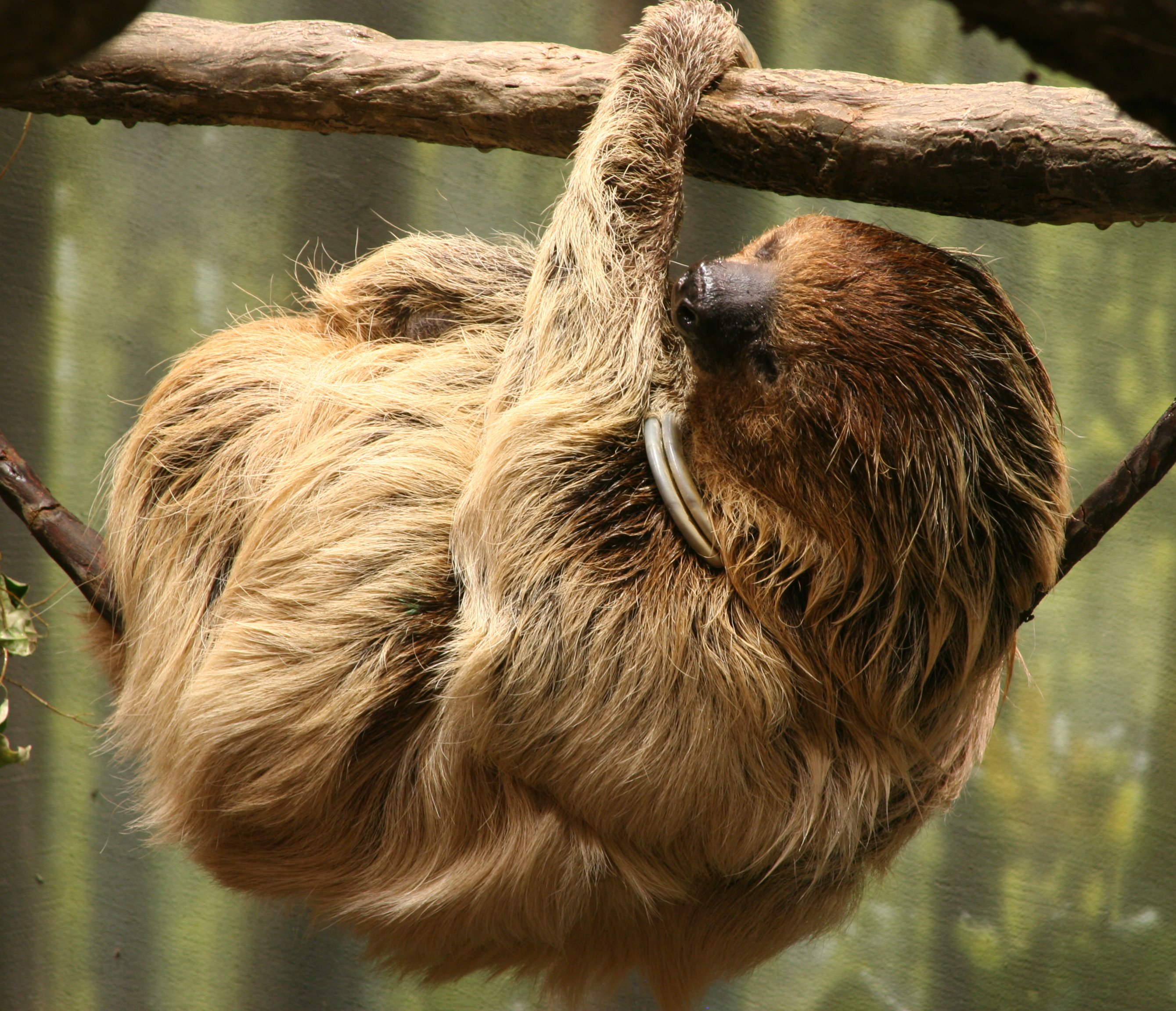
Linnaeus's two-toed sloth, or Southern two-toed sloth(Choloepus didactylus)
Phylum —chordata
Class — mammalia
Order — pilosa
Family — choloepodidae
Genus—choloepus
Appearance
Linnaeus'stwo-toed sloths have been called the slowest animals on earth. Ranging in length from 21 to 29 inches, Choloepus didactylus is roughly the size and shape of a small dog. The body is composed of a short neck (only 6-7 vertebrae) with four long limbs of equal length, ending in two curved claws. The head is short and flat, with a snub nose, rudimentary ears, and large eyes.
Choloepus didactylus are covered in long brownish-grey hair that curves from stomach to back, opposite that of most mammals. A unique feature of this fur is that each strand has grooves which collect algae, giving the sloth a greenish tint and camouflaging it from predators.
The teeth of the Southern two-toed sloth are small, simple molars that are continuously growing but constantly ground down by the mastication of food. To compensate for a lack of sharp teeth, Choloepus didactylus has hardened lips which act to shear and crop leaves.
Habitat
The range of Linnaeus’s two-toed sloth stretches through the Central America and northern South America and some parts of Brazil and Peru.
Behavior
Linnaeus’s sloths are usually solitary animals, although females can sometimes be feeding in the same tree. These animals spend as much as 15-20 hours per day sleeping. They wake up at night to feed, moving to a new tree each night, but rarely passing more than 40 meters. Most of the time is spent hanging upside down in trees. They use their long claws to cling onto branches of trees. Young often inherit home ranges of their parents. When on land, Linnaeus’s sloths are very clumsy. However, when in the water, they prove to be accomplished swimmers, using their long arms to move through water. Their main tool of self-defense is camouflage, although claws and teeth also allow these animals to defend themselves.
Diet
Linnaeus’s sloths are primarily herbivores. Their diet mainly consists of berries, leaves, small twigs, fruits and other vegetation, complemented with small prey such as insects. The typical matter of feeding is harvesting leaves with their lips.
Reproduction
It is suggested that Linnaeus’s sloths may exhibit either polygynous or polygynandrous (promiscuous) mating systems, and females appear to initiate mating. Linnaeus’s sloths mate year-round. According to observations, these animals may have a peak season, occurring in March-April. Females of this species produce young once a year. Gestation period lasts for 6 months, yielding a single baby, which lives clinging into the belly of its mother for the first 5 weeks of its life. Independence is reached at 1-year-old, although the young sloth often continues to associate with its mother until 2 years old. Age of sexual maturity is 3 years old for females and 4-5 years old for males.
Average life span of Southern two-toed sloths is 20 years in the wild, ages of 30 to 40 years have been recorded in captivity.
In captivity
In captivity, two-toed sloths quickly get used to mixed vegetable food (vegetables, salad), and willingly eat boiled eggs. Do not overdo it with fruit bought in the supermarket. They are very sweet. This contributes to the excessive growth of yeast in the sloth's intestines. Constant access to clean water is required.
The sloth does not have an unpleasant smell, but still, from time to time it should be bathed with slightly warm water. Sloths like to swim and, oddly enough, swim well.
It is necessary to equip the enclosure for sloths with strong bamboo sticks, rope nets or rope ladders. You can install a hammock. Depending on the time of year, corn stalks, young branches of fruit trees, etc. can be installed in the cage.
Sloths are very sensitive to sudden changes in temperature. Prolonged exposure to cold or heat can adversely affect their well-being. Every day you need to spray the sloth with warm water, and it is better to install an air humidifier, creating a tropical forest microclimate.
Once every six months, it is necessary to take tests for the presence of parasites in the litter. If there are any, start deworming. Deworming can be an ordinary one, the same as for dogs.
 Russian
Russian
 English
English
























